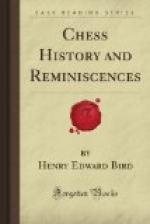5. The Draught Box and Draughtmen: The box is of dark wood, divided on its upper side by strips of ivory into 30 squares, on its under side into 20 squares, 12 being at one end and 8 down the centre; some of these contained hieroglyphics inlaid, three of which still remain, also a drawer for holding the draughts. These draughts consist of about 20 pieces, carved with most exquisite art and finish in the form of lions’ heads—the hieroglyphic sign for “Hat” in Hatasu. Also two little standing figures of Egyptian men like pages or attendants, perfect, and admirable specimens of the delicate Egyptian art. These may have been markers, or perhaps the principle pieces. Two sides of another draught box, of blue porcelain and ivory, with which are two conical draughts of blue porcelain and ivory and three other ivory pieces.
6. Also parts of two porcelain rings and porcelain rods, probably for some unknown game.
7. With the above were found a kind of salvo or perfume spoon in green slate, and a second in alabaster.
The coffin of Thotmes I and the bodies of Thotmes ii and III, were found at Dayr el Baharee in 1881, that of their sister, Queen Hatasu, had disappeared but her cabinet was there, and is now in the Boulack Museum, and I have no doubt whatever, says Miss Edwards, “that this throne and these other relics are from that tomb.”
HIEROGLYPHICS OF ANCIENT EGYPT
Note. The name which occurs most frequently on the finest monuments of Egyptian art is Ramses, which immediately recalls the names of Rhamses, Ramesses, or Ramestes, and Raamses, (Exod. i., 11) occuring in Hebrew, Greek and Roman writers, and when we find this name with all its adjuncts, distinguishing some of the finest remains of antiquity from the extremity of Nubia to the shores of the Mediterranean, we are immediately led to ask whether this must not have been the title of Sesostris. The Flaminian obelisk at Rome, its copy, the Salustian, the Mahutean, and Medicean, in the same place; those at El-Ocsor, the ancient Thebes, and a bilingual inscription at Nahr-el-Kelb, in Syria, all bear this legend. The power and dominions of this Prince, must therefore have been of no ordinary magnitude; and such was in fact that of the Rhamses, whom the priests at Thebes described to Germanicus as the greatest conqueror who ever lived (Tacit. Annal. 11 p. 78 ed, Elzevir, 1649). But none of the ancient historians give this name to Sesostris. He is however called Sethos by Manetho who tells us (Joseph, contra, Apion, 1 p. 1053) that he was also called Rhamesses, from his grandfather Rhampses, and thus affords a clue by which all doubt is removed; and as Sethos, Sesostris and Sessosis, are virtually the same name, and confessedly belong to the same person, so was the Rhamses of Tacitus and the REMSS of these hieroglyphical inscriptions, no other than that mighty conqueror. His grandfather




